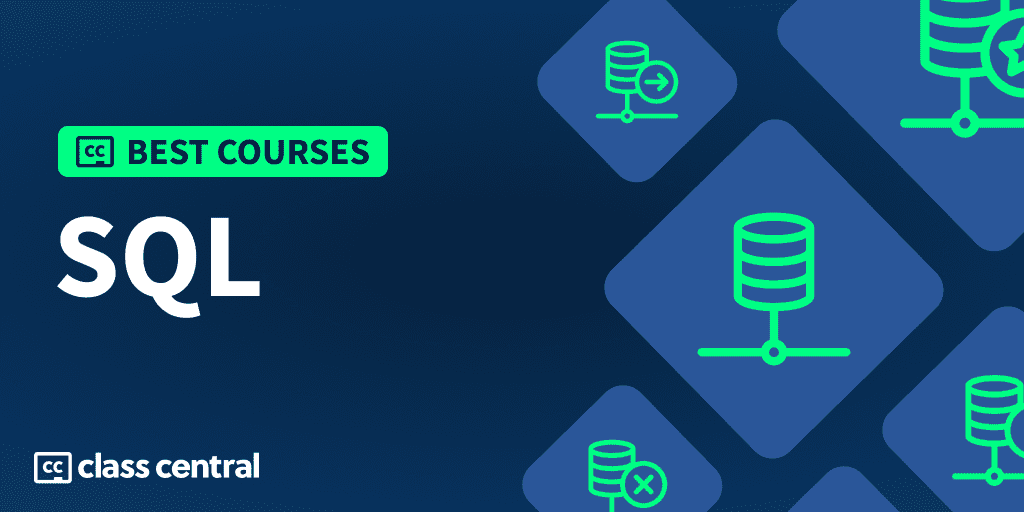SQL Courses and Certifications
Learn SQL, earn certificates with paid and free online courses from Harvard, Stanford, University of Michigan, Johns Hopkins and other top universities around the world. Read reviews to decide if a class is right for you.
Class Central's Top Sql Courses
We've picked the best online courses to learn Sql from the Class Central catalog.
Some courses are concise and get you up to speed in no time, others will be more comprehensive.
-

SQL for Data Analysis
7 reviews -


Databases: Relational Databases and SQL
3 reviews -


Introduction to SQL
1 review -
Intro to SQL
8 reviews -

Introduction to SQL
1 review -
 Cloudera
ClouderaFoundations for Big Data Analysis with SQL
-

Intermediate SQL Queries
-


The Structured Query Language (SQL)
-


SQL for Data Science
5 reviews -


Introduction to Structured Query Language (SQL)
3 reviews
All SQL Courses
-
-
Level
-
Duration
-
Language
-
- freeCodeCamp
- 24 hours
- On-Demand
- Free Video
-
- Udacity
- 4 weeks
- On-Demand
- Free Online Course
-
- Coursera
- 13 hours 57 minutes
- On-Demand
- Free Online Course (Audit)
-
- Kaggle
- 3 hours
- On-Demand
- Free Certificate
-
- edX
- 5 weeks, 4-5 hours a week
- On-Demand
- Free Online Course (Audit)
-
- edX
- 2 weeks, 8-10 hours a week
- On-Demand
- Free Online Course (Audit)
-
- edX
- 2 weeks, 8-10 hours a week
- On-Demand
- Free Online Course (Audit)
-
- Udacity
- 2 months 2 days 8 hours
- On-Demand
- Paid Course
-
- Noble Desktop
- 18 hours
- On-Demand
- $975.00
-
- Noble Desktop
- 18 hours
- On-Demand
- $975.00
-
- Boot.dev
- 30 hours
- On-Demand
- Paid Course
-
- Noble Desktop
- 6 hours
- On-Demand
- $350.00
-
- Noble Desktop
- 6 hours
- On-Demand
- $350.00
-
- Noble Desktop
- 6 hours
- On-Demand
- $425.00
-
- Udacity
- 2 weeks, 4-5 hours a week
- On-Demand
- Paid Course
Frequently asked questions about SQL
Is SQL similar to Python?
SQL and Python are developed to perform different tasks. SQL, or Structured Query Language, is a query language primarily used to query and retrieve data from tables within a database. SQL is not designed to manipulate or transform data into other formats. Python is a general-purpose programming language that can analyze and manipulate data, and is widely used today to develop applications, artificial intelligence, etc. using its tools and libraries.
Is SQL easy to learn?
Yes, SQL is easy to learn! Its English-based syntax makes it very easy to understand. SQL is not a mathematical language like Matlab, so you don’t have to be a tech-person to understand it. It uses simple English words such as SELECT, INSERT, UPDATE, and DELETE as its commands, which make it very easy if you know basic English. Also, most database engines are compatible with the SQL code.
What is the difference between SQL and MySQL?
SQL stands for “Structured Query Language”. It is a query language used to add, alter, update, or delete data from tables in a database using simple English-based commands. On the other hand, MySQL is a relational database management system (RDBMS). MySQL is an open-source platform that uses SQL.
How long does it take to learn SQL?
The answer isn’t necessarily the same for everyone. As a beginner, you might need more time to grasp the basic concepts of SQL. Once you learn to make your way through it and get to the intermediate level, you can learn faster. On an average, you may expect to learn the basics of SQL in about two to three weeks. After that, if you want to dive deeper, it would take longer to master your skills. Remember, everyone has a different learning pace, and it’s OK to take your time.
What is the best way to learn SQL?
- Determine your purpose for learning SQL
- Take online courses and consult books
- Master the basics of SQL first
- Refer to dependable resources for help
- Start with small projects and expand
- Practice is the key
What is the difference between CHAR and VARCHAR2 datatypes in SQL?
CHAR has a fixed size. If you assign, say, 20 bytes, it will always take up 20 bytes in the database, even if you store data of lesser size, say, 4 bytes. You should use CHAR only if you know the exact length of the string.
VARCHAR2 size depends on how many bytes you actually store in the database, say, 4 bytes. The size you assign, say, 20 bytes, is just the maximum number of bytes that can be stored in that variable. You should use VARCHAR2 when you don't know the exact length of stored strings, or it will waste disk space.













